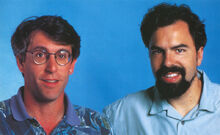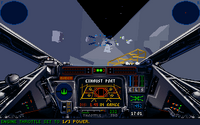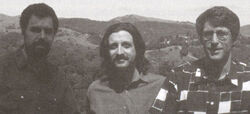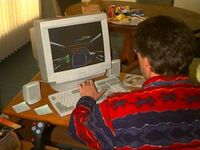- "I'm partial to the main character from Star Wars: X-Wing Alliance named Ace Azameen [sic], as I'm a fighter pilot at heart. I can play both the Rebel Alliance hero flying an X-wing and a rogue mercenary flying the Millennium Falcon, two of the coolest spacecraft ever imagined."
- ―Lawrence Holland
Lawrence Holland, also known as Larry Holland, is a video game developer best known for the X-Wing computer game series. A graduate in Anthropology and Prehistoric Archeaology from Cornell University, he entered a career in game development before starting freelance work with Lucasfilm's games division, later named LucasArts, in 1986. There he worked on several games, including the X-Wing series, starting with Star Wars: X-Wing and Star Wars: TIE Fighter. After incorporating Totally Games in 1994, he continued to develop Star Wars: X-Wing vs. TIE Fighter and Star Wars: X-Wing Alliance for LucasArts.
Biography[]
Lucasfilm Games[]
- "Many years ago, while working at Skywalker ranch [sic] on Battlehawks 1942, I overheard two people talking over my shoulder about the game I was working on. Imagine my surprise when I turned around and saw Steven Spielberg and George Lucas discussing it and learning further that Steven Spielberg was playing and enjoying it."
- ―Lawrence Holland
A native of Morristown, New Jersey,[3] born around 1957,[1] Lawrence "Dutch" Holland[5] moved to California in 1981,[6] after studying Anthropology and Prehistoric Archeaology at Cornell University.[2] Embarking on a career in game development, Holland began working as a freelancer with Lucasfilm Games in 1986, one of less than a dozen staff based in George Lucas's Skywalker Ranch.[4]
Much of Holland's early work involved programming but, with the relatively small teams assigned to each game, he soon found opportunities to work in other areas. Having already had some experience in game design, from 1988, he took on full game design and project management roles, in addition to his programming work.[4] Holland approached Lucasfilm Games with an idea for a flight simulator called Air Wing, which eventually evolved into Battlehawks 1942, the first of a series of flight simulators set in World War II.[7]
X-Wing genesis[]
- "I think that I had built up enough trust and legitimacy that I didn't have to do a big dog-and-pony show, a big pitch, or a big design document ahead of time to convince them that Star Wars was going to be in safe hands—that I could actually build an X-wing game."
- ―Lawrence Holland
By the time Battlehawks 1942 was released in 1988, Lucasfilm Games had already given some thought to the idea of a space combat simulator. The obvious subject matter was Star Wars, and then–general manager Steve Arnold met with designers to discuss applying World War II fighter-plane mechanics to space combat. As Holland's team studied more footage of dogfights during the war, they realized how closely George Lucas had based the combat scenes in the Star Wars original trilogy on similar footage and how their existing flight engine could be adapted. However, the license to produce games on the series was held by Brøderbund at the time, and the idea was put on hold.[7]

Lawrence Holland and Edward Kilham
When Brøderbund's license expired, the idea came up once more and, in February 1991, Lucasfilm Games asked Edward Kilham to begin work on the project. The game was in its planning stages while Holland was still working on Secret Weapons of the Luftwaffe,[5] the third game in his World War II trilogy,[7] and the original intention was for Kilham to lead the project himself. Kilham, however, felt that producing the kind of simulator the project required would need Holland's expertise.[5] Holland was among those at the company who initially questioned whether there was a market for such a game set in the Star Wars universe, but with renewed interest in the franchise following the release of Timothy Zahn's novel Heir to the Empire in May 1991,[7] and encouraged by Lucasfilm Games' Brian Moriarty, Holland decided the time was right, so,[9] in late 1991,[8] he joined Kilham in working on the project.[5]
X-Wing[]
- "Even though it was happening in space, the way these ships flew, the speed, the way they interacted, was very WWII-esque. So we got to migrate to this world that really drew from our roots but freed us from historical events."
- ―Lawrence Holland
As the exclusive holders of the Star Wars license, the team did not have to worry about competition as they had with their World War II efforts and found that they had more freedom in the project. Holland and Kilham each led on different parts of the game, working on design, programming and project management. Inspired by the storyline elements of Wing Commander and a desire to create a flight engine which was more engaging and allowed players flexibility in approaching missions, the two began combining Holland's technology with Kilham's cinematic approach to storytelling.[5] Evolving the flight engine first developed for Battlehawks 1942, Holland focused on programming the artificial intelligence for the game's mission builder, while Kilham developed the cinematic engine for the narrative sections.[8] The team initially used 2D bitmaps to represent the starships, a technique which involved a six-month process of drawing the ships from several angles. Much to the dismay of the artists, the decision was eventually made to switch to polygons[7] and the 3D engine developed by Peter Lincroft was technologically advanced for the time. Holland's flight engine complemented this by increasing the number of potential craft in missions from around fifteen in Secret Weapons of the Luftwaffe to around twenty-eight[5] but concerns over the new technology used by the game remained for much of the development.[7]

The Death Star trench run, as portrayed in Star Wars: X-Wing
Originally based at LucasArts, as the project team grew, Holland relocated them to a rental property in Fairfax, California.[8] The developers watched all the films in the Star Wars original trilogy, paying close attention to the style and performance of the ships, as well as looking for potential situations for the game. They also tried to tie in some elements from the growing Expanded Universe of books, comics and the West End Games roleplaying game. One of the most important elements was attempting to balance the game to ensure that the player remained central to success, in the hopes of recreating the heroic scale of Luke Skywalker's adventures.[5] Holland felt it was important to show both sides of a conflict, as he had with Secret Weapons of the Luftwaffe, and he originally planned for players to fly for either the Rebel Alliance or the Galactic Empire. However, the initial design proved too elaborate and, with a desire to get the project moving quickly, the team decided to focus on the Rebellion, trimming the scope down to something achievable.[7]
Star Wars: X-Wing was released in February 1993, the first Star Wars game published by LucasArts (as the company was now known).[10] Players control Keyan Farlander, a new recruit in the Rebel Alliance, whose story was told by the accompanying novella, The Farlander Papers, by Rusel DeMaria. Through a series of three campaigns, the player flew X-wing, Y-wing and A-wing starfighters against the Galactic Empire, culminating in the attack on the Death Star at the Battle of Yavin. Holland, however, was still uncertain about how the game would be received and whether those who had played his previous games would make the transition from World War II to Galactic Civil War.[7] The game went on to become one of the best selling games of the year[10] and received awards including Simulation of the Year in Computer Gaming World, Best Simulation of 1993 in Computer Game Review and Best Game of 1993 in Electronic Entertainment.[11] To reward their success, Lucasfilm's president, Gordon Radley, took Holland's team to dinner at the Lark Creek Inn in Larkspur, California. Holland later described the recognition from the movie-industry side of George Lucas's business as "the coolest moment."[7]
Later that year, the game received two expansion packs, each of which added an extra campaign to the game. Imperial Pursuit told of the Rebel's flight from Yavin 4 following the destruction of the Death Star, while B-wing covered the establishment of Echo Base on Hoth and the development of a new playable craft, the B-wing starfighter. The game was re-released in 1994 on CD-ROM with the expansion packs included as Star Wars: X-Wing: Collector's CD-ROM.[12]
TIE Fighter[]
- "TIE Fighter had a lot more nuance and layers, and supported you as a player by giving you better tracking information about how you were doing, with the instrumentation and so forth. Of course, we just had a cooler story to tell."
- ―Lawrence Holland

Lawrence Holland (right), with Edward Kilham (left) and Rusel DeMaria (center)
Holland and Kilham did not entirely abandon their desire to examine both sides of the Galactic Civil War. With X-Wing focused on the Rebel side of the conflict, they started to contemplate creating a trilogy, with each game looking at the war from a different perspective.[13] By the time of X-Wing's release, the developers were already developing ideas for the sequel and were "looking into the dark side."[5] With all previous Star Wars works focused on the Rebellion, Holland expected some opposition to creating a game told from the Imperial perspective, but found that those within Lucasfilm were intrigued by the concept. The team began formulating the story, taking elements from the films as a basis. Intrigued by Grand Admiral Thrawn from Timothy Zahn's Thrawn trilogy, they decided to include the character and explore his early career.[13] In developing the story, the team took care to portray the Empire as a strong military force, maintaining order in the galaxy, and not to show them as a purely evil organization.[7]
The 1994 sequel, Star Wars: TIE Fighter, sees players take the role of Imperial recruit Maarek Stele, whose story was again told by a DeMaria novella, The Stele Chronicles. The game's story sees players fight not only the Rebel Alliance, but a variety of smaller factions (as well as traitors from within the Imperial Navy itself) over the course of several campaigns. As well as revisiting the earlier idea of letting players take on the role of an Imperial pilot, Holland was also keen to address the game's difficulty, as some players had found X-Wing too challenging.[7] The final game featured multiple difficulty settings, along with an improved graphics engine and a wider variety of controllable craft, allowing players to fly the TIE Fighter, TIE Interceptor and TIE Bomber from the films, as well as the new TIE Advanced, TIE Defender and Assault Gunboat.[14] However, the decision to release the game on five floppy disks rather than CD-ROM forced the team to cut down the amount of animated cutscenes, digitized voice and sound effects to fit.[8] An expansion pack, Defender of the Empire, released later the same year, provided additional campaigns to continue the story and added the new Missile Boat as a flyable craft. In 1995, the game was re-released on CD-ROM as Star Wars: TIE Fighter: Collector's CD-ROM, which included both Defender of the Empire and the concluding expansion pack Enemies of the Empire.[12]
TIE Fighter was a major critical and commercial success for LucasArts.[7] The game was awarded Best Action Game by PC Gamer and, in 1997, was the magazine's Best Game of All Time. It was also named Best Game of the Year by Strategy Plus and entered the Computer Gaming World Hall of Fame.[11] Michael A. Stackpole was influenced by X-Wing and TIE Fighter while writing the X-wing novels and acknowledged Holland and Kilham in the books.[15]
X-Wing vs. TIE Fighter[]
- "It's a handful, but I wouldn't do anything else. There's nothing like watching a game take shape, as new features and gameplay are realized. It's exciting to get to that moment where we can stand back and say, 'It's alive!'"
- ―Lawrence Holland

Holland's company, Totally Games, was incorporated in 1994.
In 1994,[11] Holland officially incorporated his own development team,[11] settling on the name Totally Games in 1995.[2] The company returned to the X-Wing series with 1997's Star Wars: X-Wing vs. TIE Fighter. The game was based around taking the previously single-player only action of X-Wing and TIE Fighter online, allowing players to fly for either the Empire or the Rebel Alliance in multiplayer battles across a LAN or the Internet.[10] This departure from previous games in the series was prompted by Holland's continued desire to allow players to experience both sides of the Galactic Civil War, and a feeling that the technology had reached the level required to make a multiplayer game possible. The decision, however, necessitated a major shift in the series as individual players could no longer be the center of the action and teamwork would be required for success.[16]
The game allowed players to fly nine different ships from either the Empire or the Rebel Alliance and either cooperate with up to seven wingmates or compete against each other in a series of skirmishes and campaigns.[10] The game featured a new engine, making it the first in the series to use hardware accelerated graphics to provide a smoother, more detailed experience.[17] The three-person programming team often worked through the night attempting to overcome problems associated with online games at the time, such as latency and packet drops. Many problems, they discovered, were a result of Internet usage patterns—on one occasion, Holland left the office in the early hours after one problem had apparently been resolved only to discover it returned during a heavier usage the next day. During particularly heavy periods, ships would warp or disappear as the connection struggled to transfer data quickly enough, making the precision aiming required almost impossible. Data-transfer issues continued to plague the game after release, and while those playing on a LAN experienced a smooth game, those playing on the Internet were left frustrated by the technical problems.[7]

Lawrence Holland, playing Star Wars: X-Wing vs. TIE Fighter
Another common criticism of X-Wing vs. TIE Fighter was the lack of a single-player story, which had alienated some fans of the previous games.[7] This was addressed with the release of the Balance of Power expansion pack later that year, which added the B-wing as a playable ship and two story-driven campaigns consisting of fifteen missions each, one for the Empire and one for the Alliance. The campaigns could be played single player, but were designed as cooperative missions supporting up to eight players.[10] Like its predecessors, X-Wing vs. TIE Fighter was critically acclaimed and was named Best Science Fiction Simulation Game of 1997 by CNET as well as topping the 1997 Hot Holiday 100 List in Computer Gaming World.[11]
In 1998, X-Wing and TIE Fighter were re-released once more as part of Star Wars: X-Wing Collector Series. Updated for Windows 9x and to use the X-Wing vs. TIE Fighter engine, the games were bundled with a cut-down version of X-Wing vs. TIE Fighter itself, called X-Wing vs. TIE Fighter Flight School.[18]
X-Wing Alliance[]
- "In archaeology one strives to recreate the past in all its detail, to make a past culture come alive through painstaking research. Games have always been a way to make worlds and events come alive as well—a world one could step into and fully experience. So, in a way, I've never changed careers, just career titles."
- ―Lawrence Holland
Holland's most recent contribution to Star Wars was 1999's Star Wars: X-Wing Alliance, the final game in the X-Wing series. Envisioned as "Star Wars meets the Godfather,"[12] the game sees players taking on the role of Rebel recruit Ace Azzameen, flying the Rebel fighters from previous games in action against the Empire. However, the game also had a more personal story, giving the player a chance to fly YT-1300 and YT-2000 light freighters in missions for the Azzameen family. Along with an updated graphics engine, the game featured several new features such as being able to dock the ship to rearm and repair, or even switch craft, and making multiple hyperspace jumps during missions. Despite all the changes, however, X-Wing Alliance was built on the same flight-simulator technology that powered Battlehawks 1942—the seventh game to be based on the technology.[7]
In addition to the over fifty single-player missions,[10] the game built on X-Wing vs. TIE Fighter by including a multiplayer mode which overcame the data-transfer problems encountered by its predecessor. X-Wing Alliance provided both free-for-all and objective-based multiplayer battles, allowing players to customize their own scenarios and play them online.[7] Totally Games was able to significantly increase the number of ships in any one mission, allowing the epic Battle of Endor to be recreated with the player controlling the Millennium Falcon during the attack on the second Death Star.[20] X-Wing Alliance continued the series' critical success and was given an Editor's Choice award in PC Gamer as well as being named best Star Wars game by the Chicago Tribune.[11] The game was re-released in 2000, packaged with the 1998 versions of X-Wing, TIE Fighter and X-Wing vs. TIE Fighter Flight School as Star Wars: X-Wing Trilogy.[21]
Works[]
Gameography[]
| Year | Title | Contribution | Publisher | Format |
|---|---|---|---|---|
| 1993[4] | Star Wars: X-Wing |
|
LucasArts Entertainment Company[22] | PC[4] |
| 1993 | Star Wars: X-Wing Tour of Duty: Imperial Pursuit |
|
LucasArts Entertainment Company[7] | PC expansion pack[4] |
| 1993 | Star Wars: X-Wing Tour of Duty: B-Wing |
|
LucasArts Entertainment Company[7] | PC expansion pack[4] |
| 1994[4] | Star Wars: TIE Fighter |
|
LucasArts Entertainment Company[14] | PC[4] |
| 1994 | Star Wars: TIE Fighter: Defender of the Empire |
|
LucasArts Entertainment Company[7] | PC expansion pack[4] |
| 1994[4] | Star Wars: X-Wing: Collector's CD-ROM |
|
LucasArts Entertainment Company[23] | PC re-release[4] |
| 1995[4] | Star Wars: TIE Fighter: Collector's CD-ROM |
|
LucasArts Entertainment Company[24] | PC re-release[4] |
| 1997[4] | Star Wars: X-Wing vs. TIE Fighter | Project Leader & Mission Programming | LucasArts Entertainment Company[17] | PC[4] |
| 1997[4] | Star Wars: X-Wing vs. TIE Fighter: Balance of Power Campaigns | Executive Director & X. v T. Project Leader | LucasArts Entertainment Company[25] | PC expansion pack[4] |
| 1998[18] | Star Wars: X-Wing Collector Series |
|
LucasArts Entertainment Company | PC collection[27] |
| 1999[4] | Star Wars: X-Wing Alliance | Project Leader & Mission Programming | LucasArts Entertainment Company[28] | PC[4] |
| 2000[29] | Star Wars: X-Wing Trilogy |
|
LucasArts Entertainment Company | PC collection[29] |
Sources[]
 "An Interview with Larry Holland" — The Adventurer 4
"An Interview with Larry Holland" — The Adventurer 4- Star Wars: X-Wing
- The Farlander Papers
- X-Wing: The Official Strategy Guide
- Star Wars: TIE Fighter
- The Stele Chronicles
- TIE Fighter: The Official Strategy Guide
- X-Wing Collector's CD-ROM: The Official Strategy Guide
- TIE Fighter Collector's CD-ROM: The Official Strategy Guide
 XVT Balance of Power FAQ on LucasArts.com (content now obsolete; backup link)
XVT Balance of Power FAQ on LucasArts.com (content now obsolete; backup link)- Star Wars: X-Wing vs. TIE Fighter
 Sneak Preview Star Wars: X-Wing Alliance on LucasArts.com (content now obsolete; backup link)
Sneak Preview Star Wars: X-Wing Alliance on LucasArts.com (content now obsolete; backup link)- Star Wars: X-Wing Alliance
 LucasArts 20th Anniversary Profile: Larry Holland on LucasArts.com (content now obsolete; backup link)
LucasArts 20th Anniversary Profile: Larry Holland on LucasArts.com (content now obsolete; backup link)- Rogue Leaders: The Story of LucasArts
- Star Wars Year By Year: A Visual History, Updated and Expanded Edition
 "Destroy the Death Star" — Star Wars Insider 195
"Destroy the Death Star" — Star Wars Insider 195- Star Wars Year By Year: A Visual History, New Edition
